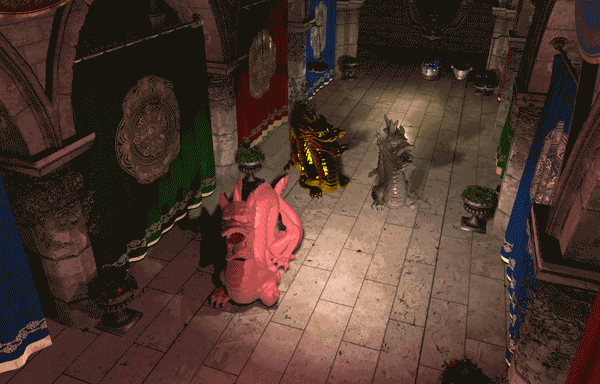I’ve made a basic point light shader, here you go
// our inputs per model
matrix World;
matrix WorldViewProj; //This is world * view * projection
// our inputs per change in lighting / draw
float3 CameraPosition;
float3 SunLightDirection;
float4 SunLightColor;
float SunLightIntensity;
#define MAXLIGHT 20
float3 PointLightPosition[MAXLIGHT];
float4 PointLightColor[MAXLIGHT];
float PointLightIntensity[MAXLIGHT];
float PointLightRadius[MAXLIGHT];
int MaxLightsRendered = 0;
//////////////////////////////////////////////////////////////
Texture2D DiffuseTexture;
SamplerState textureSampler
{
MinFilter = linear;
MagFilter = Anisotropic;
AddressU = Wrap;
AddressV = Wrap;
};
///////////////////////////////////////
//The inputs we need from the model
struct VertexShaderInput
{
float4 Position : SV_POSITION0;
float3 Normal : NORMAL0;
float2 TexCoord : TEXCOORD0;
};
struct VertexShaderOutput
{
float4 Position : SV_POSITION0;
float3 Normal : NORMAL0;
float2 TexCoord : TEXCOORD0;
float3 WorldPos : TEXCOORD2;
}
////////////////////////////////////////////////////////////////
// Our Vertex Shader
VertexShaderOutput VertexShader(VertexShaderInput input)
{
VertexShaderOutput Output;
//Calculate the position on screen
Output.Position = mul(input.Position, WorldViewProj);
//Transform the normal to world space
Output.Normal = mul(float4(input.Normal, 0), World).xyz;
//UV coordinates for our textures
Output.TexCoord = input.TexCoord;
//The position of our vertex in world space
Output.WorldPos = mul(input.Position, World).xyz;
return Output;
}
// Our lighting equations
float4 CalcDiffuseLight(float3 normal, float3 lightDirection, float4 lightColor, float lightIntensity)
{
return saturate(dot(normal, -lightDirection)) * lightIntensity * lightColor;
}
float4 CalcSpecularLight(float3 normal, float3 lightDirection, float3 cameraDirection, float4 lightColor, float lightIntensity)
{
float3 halfVector = normalize(lightDirection + cameraDirection);
float specular = saturate(dot(halfVector, normal));
//I have all models be the same reflectance
float specularPower = 2;
return lightIntensity * lightColor * pow(abs(specular), specularPower);
}
// The squared length of a vector
float lengthSquared(float3 v1)
{
return v1.x * v1.x + v1.y * v1.y + v1.z * v1.z;
}
// Our pixel Shader
float4 PixelShader(VertexShaderOutput input)
{
float4 baseColor = DiffuseTexture.Sample(textureSampler, input.TexCoord);
float4 diffuseLight = float4(0, 0, 0, 0);
float4 specularLight = float4(0, 0, 0, 0);
//calculate our viewDirection
float3 cameraDirection = normalize(input.WorldPos - CameraPosition);
//calculate our sunlight
diffuseLight += CalcDiffuseLight(input.Normal, SunLightDirection, SunLightColor, SunLightIntensity);
diffuseSpecular += CalcSpecularLight(input.Normal, SunLightDirection, cameraDirection, SunLightColor, SunLightIntensity);
//calculate our pointLights
[loop]
for (int i = 0; i < MaxLightsRendered; i++)
{
float3 PointLightDirection = input.WorldPos - PointLightPosition[i];
float DistanceSq = lengthSquared(PointLightDirection );
float radius = PointLightRadius[i];
[branch]
if (DistanceSq < abs(radius * radius))
{
float Distance = sqrt(DistanceSq);
PointLightDirection /= Distance;
float du = Distance / (1 - DistanceSq / (radius * radius - 1));
float denom = du / abs(radius) + 1;
//The attenuation is the falloff of the light depending on distance basically
float attenuation = 1 / (denom * denom);
diffuseLight += CalcDiffuseLight(input.Normal, PointLightDirection, PointLightColor[i], PointLightIntensity[i]) * attenuation;
specularLight += CalcSpecularLight(input.Normal, PointLightDirection, cameraDirection, PointLightColor[i], PointLightIntensity[i]) * attenuation;
}
}
return diffuseLight * baseColor + diffuseSpecular;
}
technique BasicLightShader
{
pass Pass1
{
VertexShader = compile vs_5_0 VertexShader();
PixelShader = compile ps_5_0 PixelShader();
}
}
Try it out and report back!
Note: In monogame you can add your shaders to your content pipeline and then load them like this
LightingEffect = content.Load(“FX/LightShader”);
Later for the models you can use them like this
LightingEffect.CurrentTechnique.Passes[0].Apply();
Before calling MyModel.Draw()
You need to supply the shader with info like CameraPosition, SunLightColor etc. every time these change.
You can do this like this
LightingEffect.Parameters[“SunLightColor”].SetValue( _mySunLightColor);
alternatively you can store/use these parameter pointers like this
Initialize()
LightingEffectWorldViewProj = LightingEffect.Parameters[“WorldViewProj”];
…
Draw()
LightingEffectWorldViewProj.SetValue(World * View * Projection);
The point lights I use like this:
Initialize()
{
_lightingEffectPointLightPosition = lightingEffect.Parameters[“PointLightPosition”];
_lightingEffectPointLightColor = lightingEffect.Parameters[“PointLightColor”];
_lightingEffectPointLightIntensity = lightingEffect.Parameters[“PointLightIntensity”];
_lightingEffectPointLightRadius = lightingEffect.Parameters["PointLightRadius"];
_lightingEffectMaxLightsRendered = lightingEffect.Parameters["MaxLightsRendered"];
}
Draw()
{
_lightingEffectMaxLightsRendered.SetValue( lightsRendered);
_lightingEffectPointLightPosition.SetValue(PointLightPosition);
_lightingEffectPointLightColor.SetValue(PointLightColor);
_lightingEffectPointLightIntensity.SetValue(PointLightIntensity);
_lightingEffectPointLightRadius.SetValue(PointLightRadius);
…
}
For each point light you need to store :
Position (Vector3)
Color (Vector4 / Color)
Intensity (float)
Radius (float)
And save these value in an array like this
Vector3[] PointLightPosition = new Vector3[MaxLightsGpu];
to be able to pass it onto the gpu like this
_lightingEffectPointLightPosition.SetValue(PointLightPosition);
I hope this basic set up helped you.



